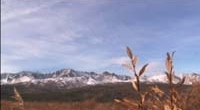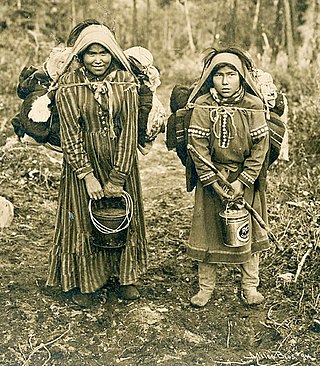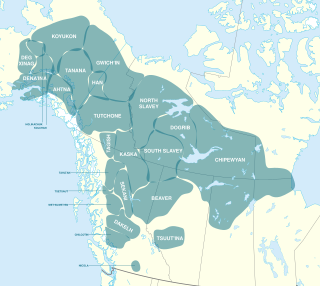Related Research Articles
Kalifornsky is a census-designated place (CDP) in Kenai Peninsula Borough, Alaska, United States. The population was 8,487 at the 2020 census, up from 7,850 in 2010. It is the most populated locality in the borough.

Tanacross is an endangered Athabaskan language spoken by fewer than 60 people in eastern Interior Alaska.

Athabaskan is a large family of indigenous languages of North America, located in western North America in three areal language groups: Northern, Pacific Coast and Southern. Kari and Potter (2010:10) place the total territory of the 53 Athabaskan languages at 4,022,000 square kilometres (1,553,000 sq mi).

Na-Dene is a family of Native American languages that includes at least the Athabaskan languages, Eyak, and Tlingit languages. Haida was formerly included, but is now considered doubtful. By far the most widely spoken Na-Dene language today is Navajo.
Denaʼina, also Tanaina, is the Athabaskan language of the region surrounding Cook Inlet. It is geographically unique in Alaska as the only Alaska Athabaskan language to include territory which borders salt water. Four dialects are usually distinguished:
- Upper Inlet, spoken in Eklutna, Knik, Susitna, Tyonek
- Outer Inlet, spoken in Kenai, Kustatan, Seldovia
- Iliamna, spoken in Pedro Bay, Old Iliamna, Lake Iliamna area
- Inland, spoken in Nondalton, Lime Village
Peter Kalifornsky was a writer and ethnographer of the Dena'ina Athabaskan of Kenai, Alaska.

The Ahtna are an Alaska Native Athabaskan people of the Athabaskan-speaking ethnolinguistic group. The people's homeland called Atna Nenn', is located in the Copper River area of southern Alaska, and the name Ahtna derives from the local name for the Copper River. The total population of Ahtna is estimated at around 1,427.

Ahtna or Ahtena is the Na-Dené language of the Ahtna ethnic group of the Copper River area of Alaska. The language is also known as Copper River or Mednovskiy.

Michael E. Krauss was an American linguist, professor emeritus, founder and long-time head of the Alaska Native Language Center. He died on August 11, 2019, four days before his 85th birthday. The Alaska Native Language Archive is named after him.

The Denaʼina, or formerly Tanaina, are an Alaska Native Athabaskan people of the Athabaskan-speaking ethnolinguistic group. They are the original inhabitants of the south central Alaska region ranging from Seldovia in the south to Chickaloon in the northeast, Talkeetna in the north, Lime Village in the Northwest and Pedro Bay in the Southwest. The Denaʼina homeland is more than 41,000 square miles in area. They arrived in the Southcentral Alaska sometime between 1,000 and 1,500 years ago. They were the only Alaskan Athabaskan group to live on the coast. Denaʼina culture is a hunter-gatherer culture and have a matrilineal system. The Iditarod Trail's antecedents were the native trails of the Denaʼina and Deg Hitʼan Athabaskan Indians and the Inupiaq Eskimos.

Northern Athabaskan is a geographic sub-grouping of the Athabaskan language family spoken by indigenous peoples in the northern part of North America, particularly in Alaska, Yukon, and the Northwest Territories. The Northern Athabaskan languages consist of 31 languages that can be divided into seven geographic subgroups.
Lower Tanana is an endangered language spoken in Interior Alaska in the lower Tanana River villages of Minto and Nenana. Of about 380 Tanana people in the two villages, about 30 still speak the language. As of 2010, “Speakers who grew up with Lower Tanana as their first language can be found only in the 250-person village of Minto.” It is one of the large family of Athabaskan languages, also known as Dené.
Koyukon is the geographically most widespread Athabascan language spoken in Alaska. The Athabaskan language is spoken along the Koyukuk and the middle Yukon River in western interior Alaska. In 2007, the language had approximately 300 speakers, who were generally older adults bilingual in English. The total Koyukon ethnic population was 2,300.
Alan S. Boraas is a professor of anthropology at Kenai Peninsula College in Alaska. He is known for his research into the culture, history, and archaeology of the peoples of the Cook Inlet area of Alaska, and in particular has worked closely with the Dena'ina people of the Kenai Peninsula. He is an adopted member of the Kenaitze Indian Tribe, and is helping the tribe develop a program to teach the Dena'ina language.
Dené–Yeniseian is a proposed language family consisting of the Yeniseian languages of central Siberia and the Na-Dené languages of northwestern North America.
Alaska Natives are a group of indigenous people that live in the state of Alaska and trace their heritage back to the last two great migrations that occurred thousands of years ago. The Native community can be separated into six large tribes and a number of smaller tribes, including the Iñupiat, Yup'ik, Aleut, Tlingit, Haida, Tsimshian, and others. Even with just a small amount of communities that make up the entire population, there were more than 300 different languages that the Natives used to communicate with one another.
Proto-Athabaskan is the reconstructed ancestor of the Athabaskan languages.

The Alaskan Athabascans, Alaskan Athabascans, Alaskan Athapascans or Dena are Alaska Native peoples of the Athabaskan-speaking ethnolinguistic group. They are the original inhabitants of the interior of Alaska.

The Tanana Athabaskans, Tanana Athabascans or Tanana Athapaskans are an Alaskan Athabaskan peoples of the Athabaskan-speaking ethnolinguistic group. They are the original inhabitants of the Tanana River drainage basin in east-central Alaska Interior, United States and a little part lived in Yukon, Canada. Tanana River Athabaskan peoples are called in Lower Tanana and Koyukon language Ten Hʉt'ænæ, in Gwich'in language Tanan Gwich'in. In Alaska, where they are the oldest, there are three or four groups identified by the languages they speak. These are the Tanana proper or Lower Tanana and/or Middle Tanana, Tanacross or Tanana Crossing, and Upper Tanana. The Tanana Athabaskan culture is a hunter-gatherer culture and have a matrilineal system. Tanana Athabaskans were semi-nomadic and as living in semi-permanent settlements in the Tanana Valley lowlands. Traditional Athabaskan land use includes fall hunting of moose, caribou, Dall sheep, and small terrestrial animals, and also trapping. The Athabaskans did not have any formal tribal organization. Tanana Athabaskans were strictly territorial and used hunting and gathering practices in their semi-nomadic way of life and dispersed habitation patterns. Each small band of 20–40 people normally had a central winter camp with several seasonal hunting and fishing camps, and they moved cyclically, depending on the season and availability of resources.

Siri Tuttle is the former director of the Alaska Native Language Center, the Alaska Native Language Archive, and a former Associate Professor of Linguistics at the University of Alaska, Fairbanks. She specializes in Dene (Athabascan) languages of interior Alaska and has contributed to the fields of acoustic phonetics, phonology, and morphology. She retired in 2021.